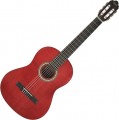The overall size of the body of the guitar.
This parameter is used to select the instrument according to the personal characteristics of the musician. Even adult guitarists can vary greatly in body type, not to mention children of different ages learning to play the guitar. Accordingly, guitars for different people should have different sizes.
It is customary to indicate the size as a fraction: for example, the largest guitars are indicated as
4/4(full size). A smaller number, accordingly, denotes a smaller case, although the proportion is not strict. For example, the total length of a classical guitar (see "Type") in 4/4 is usually 1 m, and in
3/4 is 885 mm.
The smallest instruments on the market today are 1/8. They, as well as the slightly larger 1/4, are intended for children up to 6 years of age. For the age category of 6 – 9 years, the best tool is
1/2, at 9 – 11 years old — size
3/4, for teenagers and people of petite build, models 7/8 are produced, and full
4/4 are designed for boys and adults of average and large build. At the same time, all these recommendations are rather conditional, and in fact it is worth considering not only age, but also the specific specifics of each person: for example, a 4/4 guitar that has grown up quickly at the age of 13 may be quite suitable
.... It is also worth remembering that the shape of the body also significantly affects the dimensions of the guitar (see “Shape (view”)).Scale length of the guitar. The scale in this case is the working part of the string, in other words, the distance from the saddle (on the headstock) to the saddle (on the bridge). In most acoustic and similar guitars, the scale is set during production and is unchanged. Without going into technical details, we can say that the value of this parameter is generally a reference: it allows you to some extent estimate the overall dimensions of the instrument, as well as the size of the frets (the longer the scale, the larger the size of the frets, regardless of their number). However, there is also a practical application: with an adjustable anchor (see above), the scale length data can be useful in the tuning process.

